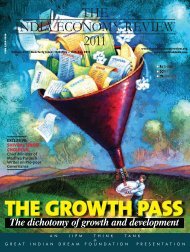Download - The India Economy Review
Download - The India Economy Review
Download - The India Economy Review
Create successful ePaper yourself
Turn your PDF publications into a flip-book with our unique Google optimized e-Paper software.
P LANNING P ARADIGM<br />
hierarchy of the world economy requires<br />
higher level of production and technology,<br />
the state pushes forward greater vertical<br />
linkages to the capitalist market and<br />
deepens their internal accumulation<br />
through exploitation of labour and nature.<br />
It is hoped that the external linkage<br />
of local economy to the world economy<br />
could reinforce the ruling elite and promote<br />
internal expansion. 5<br />
Globalisation emerged as the cannon<br />
fodder of capitalism in the mid-eighties<br />
and early nineties. Practically globalisation<br />
is nothing new, it is the establishment<br />
of the territory of the mighty across the<br />
globe through establishing the dictums of<br />
political and economic power centres and<br />
its controlling systems. In many ways, the<br />
world economy in the late 20th century<br />
resembles the world economy in the late<br />
19th century. <strong>The</strong> fundamental attribute<br />
of globalisation, then and now, is the increasing<br />
degree of openness in most<br />
countries. <strong>The</strong> openness is not simply<br />
confi ned to trade fl ows, investment fl ows<br />
and fi nancial fl ows; it also extends to fl ows<br />
of services, technology, information,<br />
ideas and persons across national boundaries.<br />
<strong>The</strong>re can be no doubt, however<br />
that trade, investment and fi nance constitute<br />
the cutting edge of globalisation. <strong>The</strong><br />
past two decades have witnessed an explosive<br />
growth in international fi nance, so<br />
much so that, in terms of magnitude,<br />
trade and investment and now dwarfed by<br />
fi nance. 6 <strong>The</strong> political stability or instability<br />
has a direct bearing on the process,<br />
pace and intensity of the globalisation<br />
and reforms, which admittedly have been<br />
slow and inadequate. 7<br />
Under the confl icting state of interests<br />
between power and people, the connecting<br />
link between human, resource, production,<br />
and nature is the worst hit. As<br />
144 THE IIPM THINK TANK<br />
Table 1: Mineral Production in <strong>India</strong> from 1970 to 2000<br />
Mineral Units 1970-71 1990-91 1999-2000<br />
A. Fuel Minerals<br />
Coal 73.7 211.3 300.0<br />
Lignite 3.5 14.00 21.9<br />
Crude oil 33.00 32.00<br />
Natural Gas<br />
B. Metallic Mineral<br />
18.00 26.4<br />
Bauxite 1.4 5.00 6.8<br />
Chromite 0.3 0.9 1.7<br />
Copper Ore 0.5 5.3 3.1<br />
Iron Ore 31.4 55.5 73.5<br />
Mn Ore 1.7 1.5 1.6<br />
Lead and Zinc Ore NA 2.7<br />
Gold Ore<br />
C. Non-Metallic Minerals<br />
NA 0.7<br />
Limestone 23.8 70.1 127.9<br />
Dolomite 1.1 2.6 2.9<br />
Gypsum NA 1.7 3.3<br />
Diamond 20 18 41<br />
All fi gures in million tones, except diamonds, which are in 1000, carats<br />
Source: Ministry of Mines annual reports 1999-00 to 2006-07<br />
the basis of all economic activity, land can<br />
either serve as an essential asset for a<br />
country to achieve economic growth and<br />
social equity, or it can be used as a tool in<br />
the and of a few to hijack a country’s economic<br />
independence and subvert its social<br />
pressure. 8 This is the context under<br />
which one needs to rethink on a broader<br />
canvas on the entire question of land<br />
rights, land reforms, the prospects and<br />
modalities of planning and developing<br />
sustainable livelihood and coexistence.<br />
Mining in the Pre and<br />
Post Globalisation Planned Era<br />
Planned mining and development, the<br />
much aphorized face of modern <strong>India</strong>n<br />
economic growth has two phases. This<br />
could be broadly categorised as the preglobalisation<br />
and post-globalisation. In<br />
<strong>India</strong>, as in most Asia-Pacifi c countries,<br />
exploitation of land for mineral resources<br />
has a long history involving abuse and<br />
plunder. <strong>India</strong>’s Five Year Plans have<br />
focused on mining to achieve ‘development’,<br />
demanding the forfeiture of people’s<br />
lands for ‘national prosperity’. Most<br />
mineral and mining operations are found<br />
in forest regions, which are also the habitat<br />
for Adivasi (indigenous) communities.<br />
<strong>India</strong> is a vast country and as such the<br />
history and status of mining varies between<br />
regions. Mining projects vary from<br />
rat hole mining, small-scale legal and illegal<br />
mining, to large-scale mining – most<br />
of which had been historically managed<br />
by the public sector. Since the introduction<br />
of private sector participation in the<br />
1990's, a number of mining related community<br />
confl icts have arisen with far<br />
reaching consequences.<br />
No doubt mining industry provided





